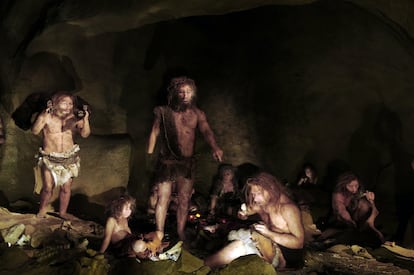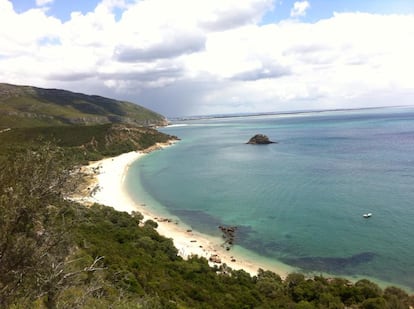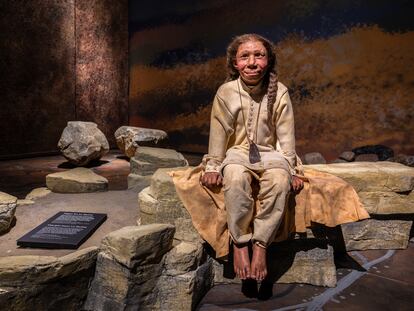Gourmet Neanderthals cooked seafood and joined forces with other clans to hunt giant elephants
Recent discoveries add to the mounting evidence that the ancient relatives of ‘Homo sapiens’ were more sophisticated than previously thought

Experts believe that the Eurasian continent was home to about 70,000 Homo neanderthalensis who roamed its southern reaches in the Iberian peninsula to the remote tundras of northern Europe, during their 200,000 years on Earth. Two studies published in early February have overturned the notion that Neanderthals lived the short, brutal and isolated existence of hunter-gatherer nomads. The studies show that clans joined forces to hunt giant elephants and prepared sophisticated seafood meals.
In an old open-pit coal mine near Halle in present-day Germany, archaeologists have excavated more than 3,000 bones, tusks and teeth from 70 Palaeoloxodon antiquus, an extinct species of giant Pleistocene-era elephants that disappeared 125,000 years ago. One study led by Sabine Gaudzinski-Windheuser from the Monrepos Archaeological Research Center and Museum in Neuwied (Germany), recently published in Science Advances, concludes that the Neanderthals hunted these massive pachyderms for at least 2,000 years during the Ice Age.
Gaudzinski-Windheuser’s team found cuts made with tools in the bones excavated from the archeological site, which was first discovered in 1980. They deduced that Neanderthals could organize strategic hunting parties with other clans and were intelligent enough to foresee the need to store food. In other words, they evolved beyond simple subsistence hunting and established a food supply of “protein bombs” stored in pantries. This finding indicates that climatic conditions may have constrained Neanderthal nomadism. The archeologists found numerous bones and some almost intact skeletons of the ancestors of today’s African elephants. They estimate that this straight-tusked elephant weighed 14 tons and was larger than a mammoth.

A Neanderthal seafood platter
On the far western edge of the European continent is a cave on the Atlantic coast that used to be about a mile from the shoreline. A Neanderthal couple would walk from there to the shore to hunt for a prized source of nutrition – seafood. Once they had caught enough brown crab (Cancer pagurus) for a meal or two, they would return to their cave to cook, perhaps because they knew about the nutritional properties of fire and enjoyed the flavor of grilled crustaceans. This was the scene reconstructed by a team led by Mariana Nabais from the Catalan Institute of Human Paleoecology and Social Evolution (IPHES), who recently published their findings in Frontiers in Environmental Archaeology. It’s the first recorded instance of Neanderthal domestic sophistication and took place 90,000 years ago in the Gruta da Figueira Brava cave on the Atlantic coast south of Lisbon (Portugal).
Nabais describes this finding as “unprecedented” and is pleased that much more research is now being conducted in caves and other sites in southern Europe, where mounting evidence demonstrates that Neanderthals lived in fixed locations for long periods. Nabais and her team analyzed crab claws and other pieces of marine life, many of them charred, to determine whether the fractures or cuts corresponded to the Neanderthal period. They ruled out the possibility that other animals had brought the shells and bones there, or that they were deposited in the cave by coastal erosion. The cave wasn’t discovered until the 1980s because eons of rocky sediment deposits had covered its opening. Nabais is amused at the thought of a Neanderthal gourmet seafood banquet and says it demonstrates “preparation and planning because it’s a meal that takes time to make.”

Both studies show that these hunter-gatherer groups moved camps according to seasonal needs. Prehistory researcher Igor Gutiérrez Zugasti says that unlike us, evidence suggests Neanderthals “integrated into their environment. They moved around according to the weather and their needs.” He believes they sought refuge in Mediterranean caves during glaciation and then returned to the great Eurasian steppe at the end of that period.
Gutiérrez, a professor at the University of Cantabria (Spain) who did not participate in either study, says that other research has noted how Neanderthals guarded herds of wild animals along their migratory routes to learn about them. “It is not the same as herding,” he said. There is undeniable evidence of generational knowledge transfer, reflected in tools made by individual tribes and in their cooking practices.
Gutiérrez says the recent studies have finally ended the idea that Neanderthals only ate meat. This is a myth, much like others that were discredited in the late 20th century about interspecies procreation, or that their coarse features indicated low cognitive abilities. “They were not so different from Homo sapiens in intelligence, and maybe less so in social behavior,” said Gutiérrez, who believes the dividing line “between them and us” has become even more blurred. He considers both discoveries “fantastic” since they highlight how hunter-gatherer societies shared their knowledge with other clans. Gutiérrez says what we know about Neanderthals has expanded well beyond the narrow-minded 19th-century view of their inferior intelligence, social simplicity and rudimentary diet. For Mariana Nabais, “Our discoveries are the last nail in the coffin of the archaic notion that Neanderthals were primitive cavemen.”
Sign up for our weekly newsletter to get more English-language news coverage from EL PAÍS USA Edition
Tu suscripción se está usando en otro dispositivo
¿Quieres añadir otro usuario a tu suscripción?
Si continúas leyendo en este dispositivo, no se podrá leer en el otro.
FlechaTu suscripción se está usando en otro dispositivo y solo puedes acceder a EL PAÍS desde un dispositivo a la vez.
Si quieres compartir tu cuenta, cambia tu suscripción a la modalidad Premium, así podrás añadir otro usuario. Cada uno accederá con su propia cuenta de email, lo que os permitirá personalizar vuestra experiencia en EL PAÍS.
¿Tienes una suscripción de empresa? Accede aquí para contratar más cuentas.
En el caso de no saber quién está usando tu cuenta, te recomendamos cambiar tu contraseña aquí.
Si decides continuar compartiendo tu cuenta, este mensaje se mostrará en tu dispositivo y en el de la otra persona que está usando tu cuenta de forma indefinida, afectando a tu experiencia de lectura. Puedes consultar aquí los términos y condiciones de la suscripción digital.
More information
Últimas noticias
Imelda Castro, the woman who wants to rule the cartel battleground of Sinaloa
The new victims of the Republican war on Obamacare: Millions hit by soaring health insurance premiums
A country divided on migrant rights: Some US states expand protections while others restrict them
Venezuela authorizes the release of another 87 political prisoners
Most viewed
- David King, chemist: ‘There are scientists studying how to cool the planet; nobody should stop these experiments from happening’
- Reinhard Genzel, Nobel laureate in physics: ‘One-minute videos will never give you the truth’
- Oona Chaplin: ‘I told James Cameron that I was living in a treehouse and starting a permaculture project with a friend’
- Sinaloa Cartel war is taking its toll on Los Chapitos
- The Interoceanic Train, the Mexican alternative to the Panama Canal










































